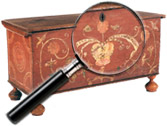Isaac Vose (1767-1823) and Isaac Vose, Jr. (1794-1872), Boston Cabinetmakers from 1819-24.
|
|||||||
|
Harold Von Schmidt (1893 to 1982) Harold Von Schmidt was born in Alameda, California and was raised by his grandfather after he was orphaned at the age of 5. His art studies began at the College of Arts and Crafts in Oakland, then continued at the San Francisco Art Institute. He was athletic as a youth, and competed in the 1920 Olympics as a rugby team member. Later he worked as a lumberjack, a [...] Click here to continue reading. Fritz G. Vogt (1841-1900) An itinerant artist in western New York state, Fritz Vogt immigrated from Germany in 1890, where he was born in 1841, and worked primarily in the five counties west of Albany from that time until his death in 1900. Vogt specialized in architectural portraits and created more than 200 known works, at least 130 of them in Montgomery County. Another 60 drawings record locales in Schoharie County, 15 were executed [...] Click here to continue reading. Vindex Banks The Vindex Company is perhaps most well known for its role as a sewing machine manufacturer in Belvidere, Illinois. Although little is known about the reasons behind their venture, Vindex briefly moved into bank manufacturing during the early 20th century. The company produced a number of mechanical banks and at least two still banks during this era. The Victor Victrola Model XVI Phonograph An upright floor model, the Model XVI was the original internal-horn Victrola; first introduced in 1906, it remained the Victrola flagship model for many years. Although it was originally advertised as “Victrola the Sixteenth” (XVI), the metal identification tag first used a “VTLA” designation. The first VTLA’s used the mechanics from the deluxe Victor 6 external horn phonograph, along with a flat-lid cabinet design that made access to [...] Click here to continue reading. The Victor Victrola Model XIV Phonograph A floor model, the XIV was introduced in 1910, to fill the gap between the new tabletop X and XI models and the $200 flagship XVI. The earliest XIV models had a squarish look, with minimal decorative trim and unusual curved Queen Anne legs. These models also used gold plated hardware. The design was modernized to closely match the newly redesigned Model XVI in late 1912. The cabinet [...] Click here to continue reading. The Victor Model X Victrola Phonograph The Victrola X had a production run from 1910 to 1921. It was first made as a table top phonograph and in 1912 it was made into a stand-up Victrola. The early models had a single spring motor. In October 1917 a new style double spring motor was used and the model number was changed to a X-a. It has a 12 inch turntable and was available in [...] Click here to continue reading. The Victor Victrola Model VI Phonograph A lidless table-top phonograph, the Victor Victrola Model VI was a slight upgrade from the base IV model, offering a 2-spring motor and slightly larger case. Production was started in October of 1911, and discontinued in 1925. Early models were available only in oak but eventually both oak and mahogany versions were produced. During the first few years of production, the VI came with a 10-inch turntable, which [...] Click here to continue reading. The Victor Talking Machine Model IV Phonograph A lidless table-top phonograph, the Model IV was Victor’s lowest priced model for many years. Production was started in September of 1911, and discontinued in early 1926. Catalogs state that the only finish was Oak, although several mahogany versions have turned up, made near the end of the model run. Very early models had a stamped steel grille covering the horn; subsequent versions had conventional wood slats. [...] Click here to continue reading. The Victor Victrola Model 80 Phonograph The VV-80 was the lowest-price upright floor model, introduced when Victor updated its product lineup in 1921. It was formerly known as the Model X. The Model 80 was a rather small and basic phonograph, with a minimum of decoration. Trim was machined rather than hand-carved. All Model 80′s had the semi-automatic brake and a two-spring motor. The VV-80 was available in mahogany, oak or walnut, but the [...] Click here to continue reading. |
|||||||
|
Copyright p4A.com, ltd. & Internet Antique Gazette - 2026 - All Rights Reserved |
|||||||
